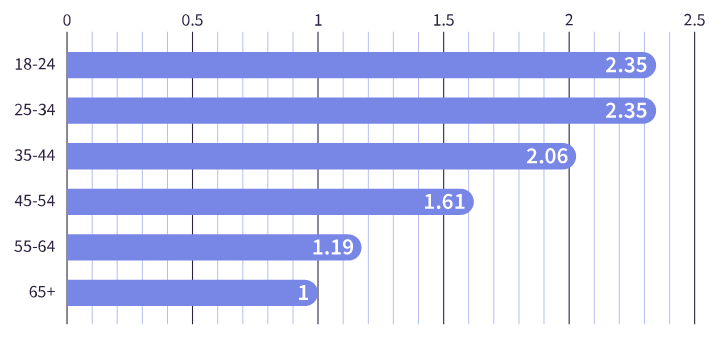Discovery why smart entrepreneurs are embracing the subscription model

More people are getting subscription-based products and services. The US is leading the charge with 69% of Americans having multiple subscriptions.
Globally, 27% of people say they will increase their number of subscriptions. These include consumers in the US (36%), Italy (25%), Canada (23%), and the UK (21%). These figures should give subscription providers reason to smile.
People are not just subscribing from the usual suspects of online movies, apps and digital products. The subscription business model is also being adopted by traditional one-and-done sellers like car companies.
There’s also the Dollar Shave Club which pioneered the subscription model for men’s personal care products. Their YouTube video has 27 million views and counting.
Mobility, security, office space, supplements, personal care and many more, a lot of businesses are finding new streams of revenues from the subscription business model.
Now is the subscription business model right for your small startup business? The quick answer is probably. Almost any type of business can use the subscription model, well, almost.
The longer answer may not be as cut and dry. Here is what you need to think about before diving headfirst into this growing trend:
1. Know the needs of your customer

Any business must solve the problem of their target customer. A subscription business model is no exception. If you offer your service or product as a subscription will it make life easier for your customers?
With the coronavirus still hanging around, people are worried about exposing themselves to the virus, especially the elderly. Your customers will stay safe if they just receive your product at their doorsteps. This is something they should know about.
Ask your regular customers or members if they will find a subscription offering helpful to their needs. Your regulars are a valuable source of feedback that can help you package and launch your subscription the right way.
Subscription answers three basic needs of customers. Your business will fall into one of these:
1. Replenishment: People need these products or services regularly. They are pretty much fixed on the brand. They don’t want to think about it. They just want it to be there when they need it.
You can deliver to your customers on a predictable schedule based on when they need a re-supply. You can also give discounts if they order extra. Ex: supplements and medicines, pet food, produce, meat and poultry products, personal hygiene products.
2. Curation: People want these types of products but are open to exploring various brands within the niche.
You can supply these products in boxes which you deliver to customers regularly. This is great for introducing new brands to people. Ex: clothes, personal grooming products, kids educational material, toys, gardening kits, etc.
3. Access: People like the idea of exclusivity and discounts. This is especially true if they see value in it.
You can start a membership club for your business with exclusive items, perks, and big discounts for members. Ex: Costco, Sam’s Club, BJ’s Wholesale Club, Netflix, Disney+, HBO Max, etc.
Exclusivity is another strong attraction of subscriptions. People have the fear of missing out. We like to think that we belong.
Make sure that your members will have special items, services, or prices that will only be exclusive to them. You can add more incentives if they commit long-term. Ex. National Geographic, Apple Store, Nike, wine club memberships, etc.
2. Make sure your product or service can handle it

If you are offering a product, subscriptions mean shipping your products over to the customer. The question you need to ask is will it get there in one piece?
Some products require special packaging such as glasswork and porcelain. Other products are time-sensitive like food, flowers, and farm produce that need to get to the customer as fresh as possible.
For services such as contracting and repair work, it can be difficult to offer the simplicity and tiered approach of subscription pricing.
Repairmen would have to inspect the site themselves to properly appraise the fix required.
Plumbing work, for example, can turn into a major teardown and patch-up work. This will simply not work unless you can find a way to standardize your fees.
3. Built-in the three main attractions of subscriptions

1. Convenience is one of the main attractions of subscriptions for the customers. They don’t have to go out, find parking, hustle in the crowd, checkout at the cashier, drive away and fill up with gas.
Is this what your business is offering to your customers? They don’t have to make the trip to your store. Your store comes to them. You bring them what they need on regular and predictable schedules.
2. Simplicity is what some people want in subscriptions. They just pay for the product or service and it shall be done. Easy peasy lemon squeezy.
No need to think about it until the time they will use it. It makes their budgeting easier since it’s a recurring cost.
Remember how you always run out of toilet paper at the wrong time? With subscriptions, people need not worry about running out of personal grooming products, toiletries, and supplements.
3. Variety finds the perfect platform in a subscription business model. You can give free samples of new products in their monthly deliveries to increase your offering. A new freebie every month can be included in their boxes just to keep your customers delighted. You can have themed products like Mothers Day special or even a birthday card for a personal touch.
4. Set up the proper technology

Technology enabled the subscription business model to jump from the realm of magazines and newspapers to almost any product or service you can think of today.
You must have the technology in place if your small business is to make a successful dive into subscriptions. Don’t do this by yourself. Get the experts to do it for you.
What you need is an automated payment system that takes in credit cards, e-wallets, debit cards, mobile payments, bank transfers, and e-checks.
Of course, you won’t be able to set up an online payment system if you don’t have a website. Make sure you have a robust and secure website and hosting that can handle payments.
5. Fulfill on a sustained basis

Subscription means you will have remote customers in various locations. Don’t serve every state in the country. Your resources will be strained as it is.
Keep it local and among your patrons and regulars only. This will keep things from spiraling out of control when your system, manpower, and logistics are just in the break-in stage.
You will have to ship your products to your customer regularly. That’s where the right courier service comes in.
Do your research and who does the best in a particular area. Better yet, give your customer the choice if they want postal service, UPS, DHL, FedEx, or any other service that they prefer. A simple messenger service can be the best in your immediate community.
Now if you offer services like cleaning, laundry, or security, make sure you have trained and certified personnel in the area. These people represent your company. Your staff who meet your customers must bring with them a delightful brand experience.
6. Test it in the community

Small businesses will always have one thing big companies strive to have. That is the community. Your neighborhood knowledge, reputation, and relationships are valuable assets to your business. Make them work for you.
Before you go full-blast into subscription, make sure you test it within your community, friends, and relatives. This will allow you to see concerns that may turn into problems if you scale too soon.
You will also get valuable feedback on your product or service. Don’t assume what your customers will like or not like.
7. Keep your other revenue models up?

Don’t shut down your other streams of income. Keep your brick-and-mortar store that does business face-to-face with customers.
Not everyone will sign up. Some people will stick to pay-per-product no matter what you offer them.
Others will test your product first and decide later if it is worth a monthly subscription.
Your physical store is also a valuable source of training for your new staff, customer feedback, and product testing.
The same with your e-commerce website for pay-per-product. Don’t take these down.
Those who are not familiar with your brand may want to test your products first before trusting you. These conversions are your new customers. Your subscription is what retains your customers.
The subscription business model doesn’t have to be a zero-sum game. Retain your established business models. You need them as a fallback and to support your fledgling subscriptions.
8. Make it easy for your customers

Some people are averse to long-term commitment. They don’t want to be locked into something that they may not need when their situation changes.
This concern is perhaps the biggest reason why people turn down subscriptions. Churn, which is a bane of subscriptions, may be an even bigger issue if you don’t address this.
In a recent study, the biggest concern was that subscriptions were too difficult to cancel. About 46% found themselves locked into frustrating long-term financial commitments. While 35% said they had overpaid for a subscription they no longer use.
Take that concern and fear away from them by making it easy to cancel anytime instead of locking them yearly.
But don’t take away a yearly payment option. Making it more affordable for your customers to subscribe long-term.
Offer 20 percent off if they go yearly instead of monthly. Always give them value and make them feel in control at every step of the journey.
Final thoughts
Studies have shown that the subscription business model is here to stay.
Young people (18-24 years old) were the heaviest users of subscriptions with an average of 2.35. About 38% of this age group also expect to increase their number of subscriptions over the next 12 months.

The table above shows how many subscriptions per age group.
There’s more. Almost every demographic expects to increase, more than decrease, their subscriptions. Consumers aged 25-34 (35%) and 35-44 (37%) are strongly expected to increase subscriptions.
About 9% of the 65 and over group still expect an increase in subscriptions, while 81% will keep their current volume.
With this data, it is clear that more small businesses, no matter the external factors such as the pandemic, should look into subscription models to serve their customers of all ages.
